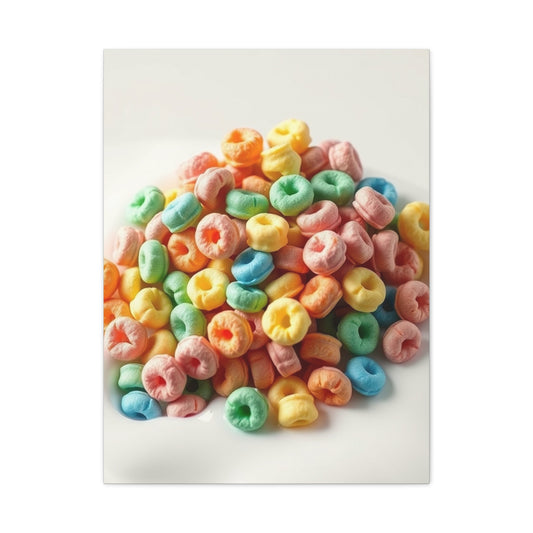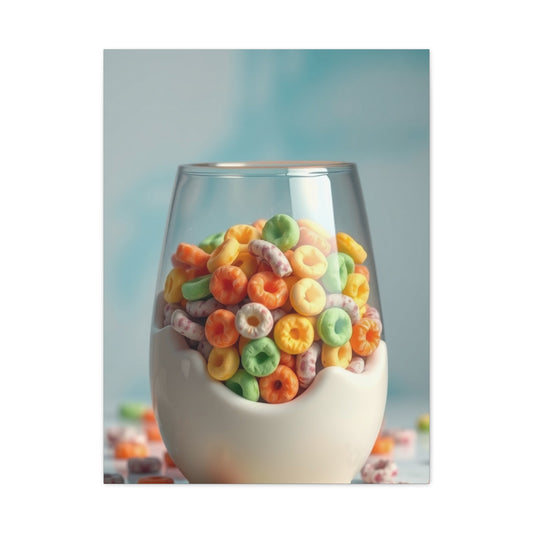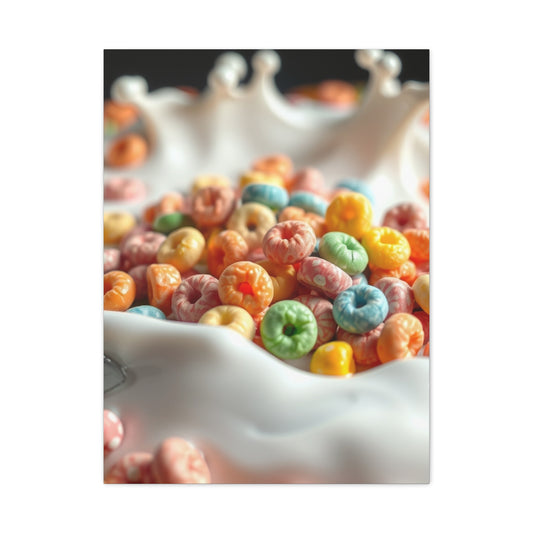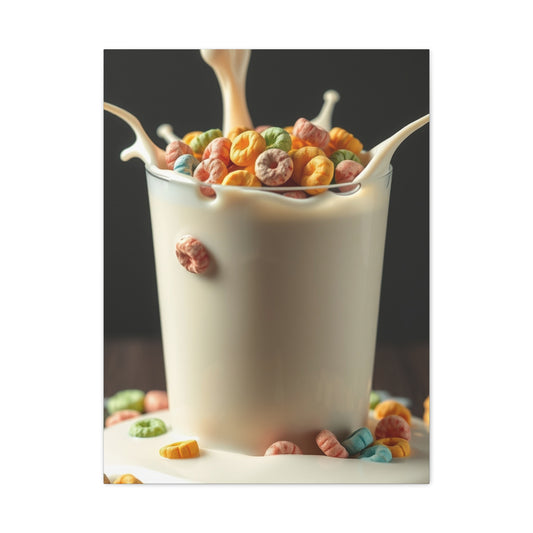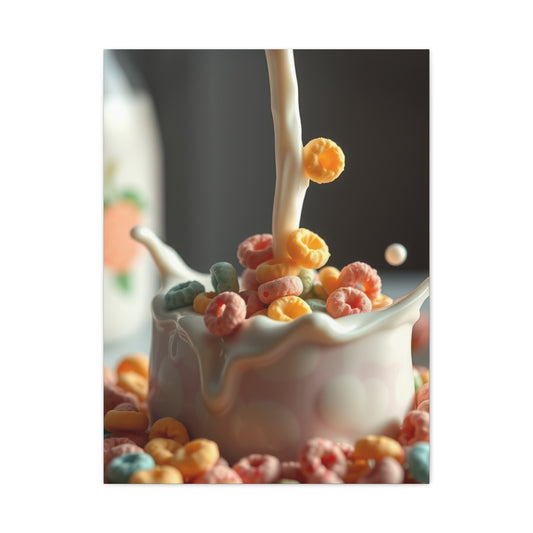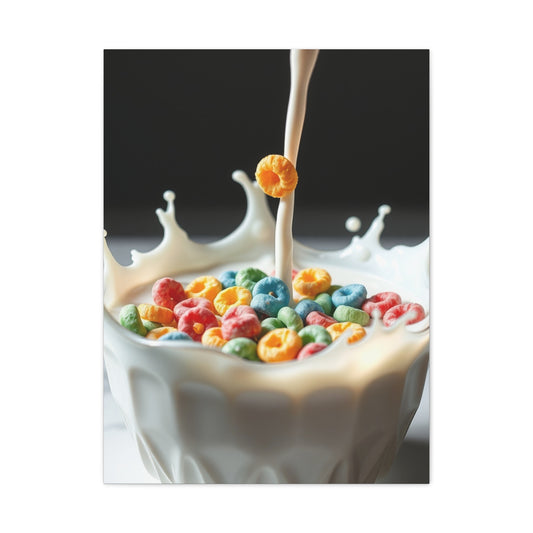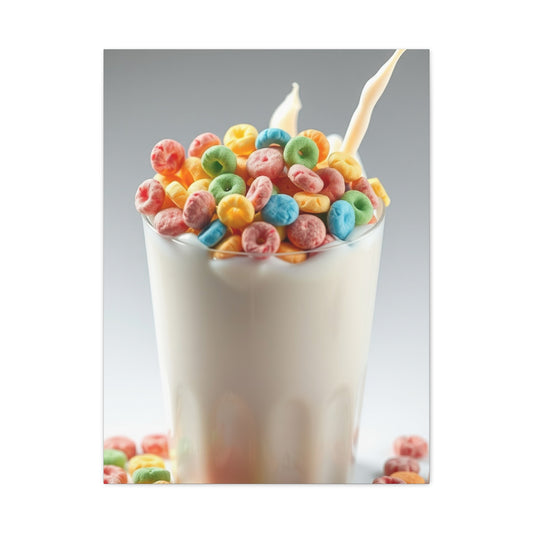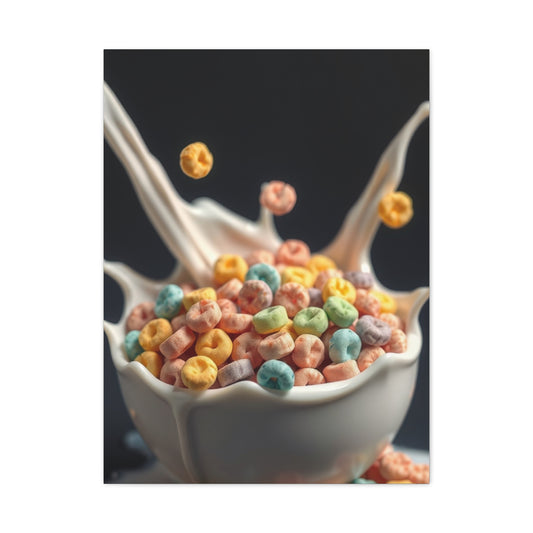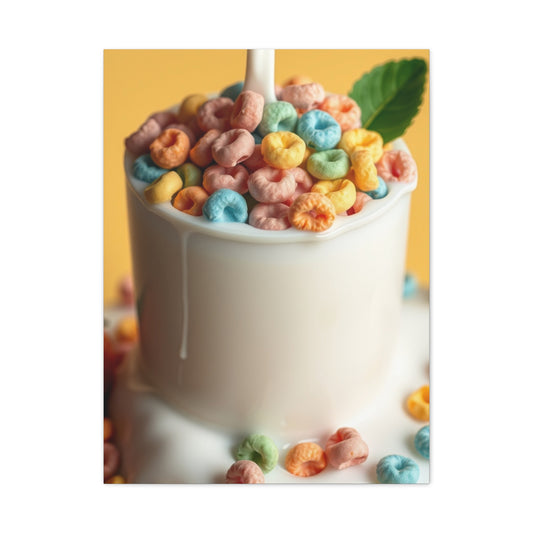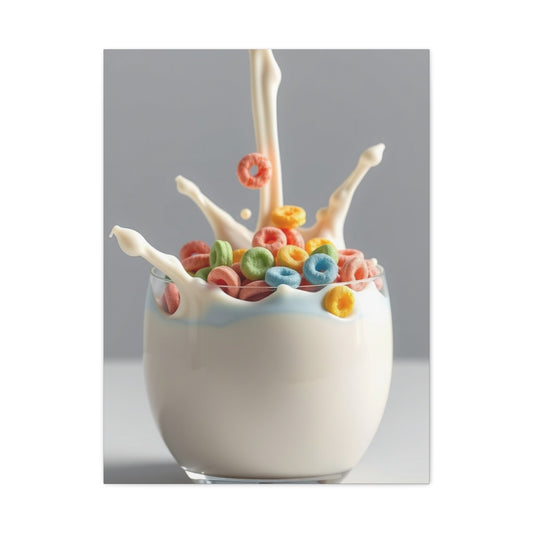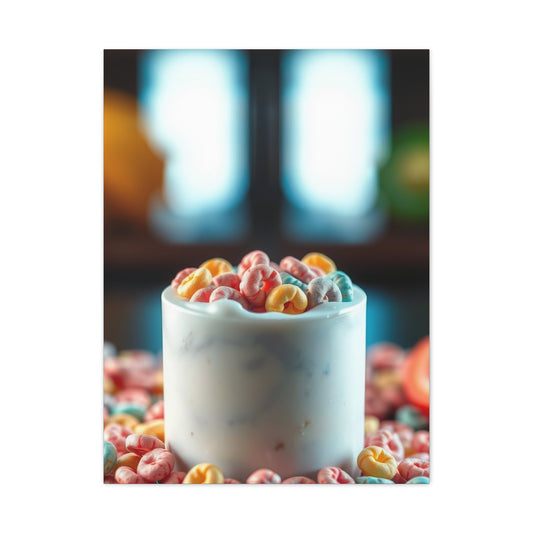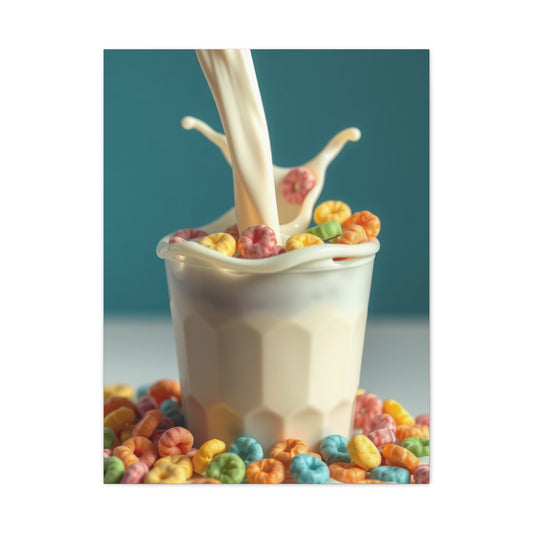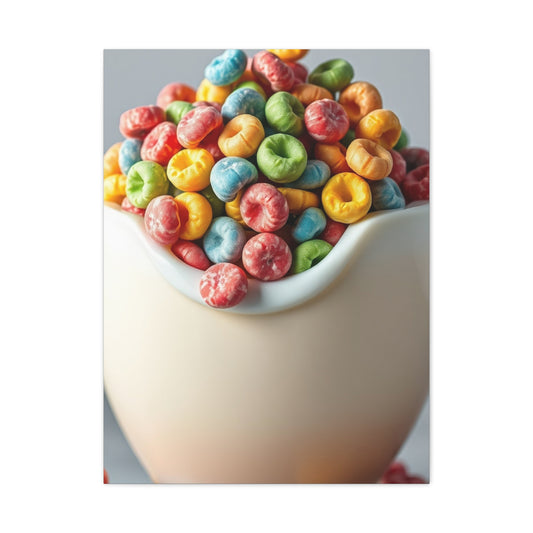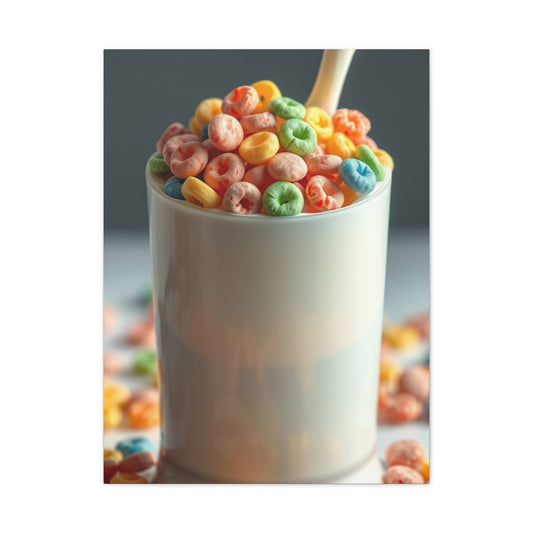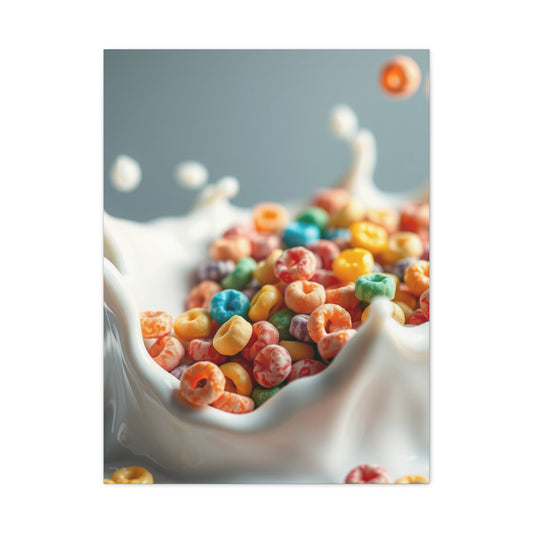Complete Guide to Crafting Edible Paint with Fruit Loops in Milk Art
Art and food have always shared a fascinating and colorful relationship. Across history, people have used food not just as nourishment but also as a form of creative expression. From intricate cake decorations in royal kitchens to the delicate beauty of latte art, culinary design has consistently blurred the line between cooking and artistry. In today’s world, this playful connection continues to evolve, and one of the most exciting and whimsical examples is edible paint made with Fruit Loops in milk art.
This imaginative craft transforms a familiar childhood favorite—Fruit Loops cereal—into a vibrant set of edible colors that can be brushed onto cookies, cakes, rice paper, or other food-safe canvases. The result is a fun, interactive activity that delights children, families, artists, and even professional bakers who want to explore new ways of decorating. What makes this method especially appealing is its accessibility: all you need is a box of Fruit Loops, some milk, a few small containers, and a clean paintbrush to unlock a rainbow palette of edible paints.
The idea behind Fruit Loops edible paint is simple yet fascinating. Each colorful loop is coated with food-safe dye, which dissolves naturally when soaked in milk. The milk absorbs the bright pigments, transforming into a safe liquid paint that can be applied directly to edible surfaces. Not only does this process encourage artistic creativity, but it also introduces children and beginners to the science of diffusion and color mixing in a hands-on, enjoyable way.
In this complete guide, we’ll walk you through everything you need to know—from the origins and history of edible art to the exact steps of crafting Fruit Loops paints, as well as techniques, tips, and project ideas to inspire your edible masterpieces. By the time you finish, you’ll see how something as simple as breakfast cereal can be transformed into a lively medium for creativity, fun, and flavor.
The Intersection of Food and Art
The relationship between food and art has existed for centuries, transcending cultures and time periods. Long before modern culinary schools began teaching plating aesthetics or Instagram made colorful food trends go viral, ancient societies already recognized the power of food as a visual and symbolic medium. Festivals in ancient Egypt, Greece, and China featured decorated breads, carved fruits, and confections painted with natural dyes. These creations were not just edible treats but also symbols of abundance, spirituality, and celebration. In medieval Europe, elaborate sugar sculptures called subtleties were presented during royal feasts as both entertainment and edible displays of wealth and craftsmanship.
In today’s world, the idea of food as art continues to thrive in countless forms. Fine-dining chefs spend years perfecting the artistry of plating, where balance, symmetry, and color contrast make a meal as visually delightful as it is delicious. Bakers transform cakes into masterpieces that resemble bouquets, sculptures, or painted canvases. Food stylists meticulously arrange ingredients for advertising and media, turning everyday meals into picture-perfect designs. Even casual home cooks enjoy experimenting with presentation—sprinkling herbs to add visual freshness, arranging colorful vegetables, or layering desserts to create appealing textures and hues.
Within this broad spectrum of food artistry, edible painting has carved out its own niche. Techniques such as decorating cookies with edible watercolors, writing calligraphy in chocolate, or airbrushing cakes with food-safe pigments showcase the fusion of culinary skill and visual creativity. These methods not only enhance the sensory experience of eating but also transform food into a storytelling medium. Every brushstroke, color choice, and design element can carry personal meaning, cultural references, or playful whimsy.
One particularly charming and accessible example of edible art is the use of Fruit Loops milk art. This concept takes inspiration from childhood nostalgia while offering an easy, hands-on craft that anyone can try at home. By soaking Fruit Loops in milk, the cereal’s artificial coloring releases into the liquid, creating a natural palette of vibrant edible dyes. The resulting milk takes on shades of red, blue, green, yellow, and orange—almost like a watercolor paint set, but safe enough for children to use and consume.
The beauty of this method lies in its simplicity and versatility. With just a bowl of cereal, some milk, and a little imagination, you can create edible paints that work on multiple surfaces. For instance, bakers can brush the colored milk onto cookies, marshmallows, or frosted cakes to create playful designs. Children can dip brushes or even their fingers into the colors and decorate rice paper or edible sheets, combining snack time with an art project. Educators can also integrate Fruit Loops milk art into classroom activities, using it as a way to explore both artistic expression and basic science concepts such as color mixing, solubility, and absorption.
Beyond its practical uses, Fruit Loops milk art embodies the joy of blending two creative worlds—food and visual expression. It transforms an everyday breakfast item into a tool for imagination. The activity is inherently inclusive: it requires no special skills, expensive tools, or advanced training. Families can enjoy it together as a rainy-day activity, while hobbyists can use it to add unique flourishes to their homemade treats. The edible paints are non-toxic and familiar, which makes them especially appealing for children’s parties, workshops, and community events where safety and fun are equally important.
This playful approach also reflects a larger cultural shift toward embracing imperfection and creativity in everyday life. Unlike the precision of professional patisserie or fine dining, Fruit Loops milk art encourages experimentation. Colors may blend unexpectedly, strokes may be messy, and designs may turn out differently than planned—but that unpredictability is part of the charm. It highlights the idea that art doesn’t always have to be permanent or flawless to be meaningful. In this case, the artwork disappears the moment it’s eaten, leaving only the memory of the shared experience.
Why Fruit Loops? The Magic of Cereal-Based Colors
When it comes to edible paint, Fruit Loops stand out as an unexpected yet brilliant choice. At first glance, they might seem like nothing more than a sugary breakfast cereal, but hidden within their bright, playful rings is the key to creating a rainbow palette of edible paints. Each loop is coated in a vivid food coloring that is designed not only to attract the eye but also to be completely safe for consumption. This makes Fruit Loops a perfect foundation for crafting edible paint, especially for family-friendly activities where safety and creativity go hand in hand.
The magic lies in how easily the colors dissolve in milk or water. Unlike traditional food dyes that require careful mixing or powders that may clump, Fruit Loops release their pigment almost instantly when soaked. Within minutes, the liquid transforms into a pool of bright pink, orange, green, or purple, giving you ready-made edible paint without any additional steps. This simplicity makes the process approachable for children, parents, teachers, and even beginner bakers who may not want to invest in specialized edible inks or color powders.
Another advantage of using Fruit Loops is the wide range of hues they offer straight from the box. Red, yellow, green, purple, and orange provide a foundational rainbow spectrum, and with a little mixing, you can create secondary shades like teal, peach, or even brown. This natural versatility encourages experimentation with color theory, blending, and layering—skills that can be both artistic and educational.
Perhaps the most underrated aspect of Fruit Loops is their fun factor. Children already associate the cereal with joy, playfulness, and breakfast-time comfort. When you transform those loops into paint, you add another layer of wonder, turning an ordinary snack into a magical tool for art. Unlike synthetic paints or store-bought edible gels, this approach sparks imagination and adds a sense of discovery to the creative process.
Ultimately, Fruit Loops make edible art accessible and engaging. With just a box of cereal and some milk, you can produce vibrant, safe, and interactive paints—proving that sometimes the simplest household items hold the greatest artistic potential.
Step-by-Step Process for Making Edible Paint with Fruit Loops
One of the best things about Fruit Loops milk art is that it’s incredibly easy to create at home. You don’t need expensive baking tools, professional culinary training, or hard-to-find ingredients. With just a box of Fruit Loops, some milk, and a little patience, you can create your own edible paint palette. Below is a step-by-step guide that anyone—from curious kids to enthusiastic bakers—can follow.
Step 1: Separate the Cereal
Begin by sorting the Fruit Loops into different color groups. While you can mix them together for a rainbow-like blend, separating them will give you more control over the vibrancy of each hue. For instance, grouping all the red loops in one bowl will result in a stronger red paint, while mixing red and yellow could give you an orange shade. This step is optional, but it allows for more precise color creation. Children especially enjoy this stage, as it feels like a playful sorting game before the painting even begins.
Step 2: Add Milk
Once your colors are separated, pour just enough milk into each bowl to cover the cereal pieces. The milk acts as your base medium, similar to water in watercolor painting. Stir gently to help release the coloring from the cereal’s surface. You don’t need to use large amounts; a few tablespoons per color are usually enough. Let the mixture sit for about five to ten minutes to allow the colors to transfer.
Step 3: Extract the Color
After soaking, you’ll notice the milk has taken on the bright tones of the cereal. Now, strain out the Fruit Loops using a spoon or a small strainer. What remains is vibrantly tinted milk in your chosen shade. At this stage, you can experiment by combining two different tinted milks to create new colors, such as mixing red and blue for purple. This process introduces kids to the basics of color theory while keeping the activity fun and edible.
Step 4: Create Your Palette
Transfer the colored milk into small cups, jars, or even an artist’s palette if you have one. This makes it easier to dip brushes and keep the colors organized. You’ll end up with a variety of edible paints that resemble a watercolor set, ready for creativity. For a richer tone, you can let the milk sit a little longer with additional cereal pieces, intensifying the shade.
Step 5: Begin Painting
Now comes the most enjoyable part—painting! Dip a clean, food-safe brush into your edible paint and begin decorating your canvas. Cookies, rice paper sheets, marshmallows, frosted cakes, or even pancakes make excellent edible surfaces. The milk paint creates soft, watercolor-like effects that lend themselves well to abstract designs, patterns, or playful doodles. Children can finger-paint directly with the tinted milk, turning snack time into an art session. The best part? Once the painting is complete, the artwork is entirely edible.
Tips for Best Results
-
Use whole milk or 2% milk for slightly richer colors.
-
Try experimenting with layering colors for depth, just like traditional painting.
-
If painting on frosted cakes, let the frosting firm up first so the paint adheres without smudging.
-
Work quickly once the paint is ready—milk-based colors can lose vibrancy if left sitting too long.
By following these simple steps, anyone can transform a bowl of Fruit Loops into a creative toolkit for edible art. It’s not just about decorating food but also about engaging the imagination, encouraging play, and creating moments of joy around the table. Whether you’re hosting a birthday party, teaching a classroom activity, or simply exploring a rainy-day project with family, Fruit Loops milk art offers a colorful and delicious way to merge creativity with taste.
Creative Projects with Fruit Loops Edible Paint
The beauty of crafting edible paint with Fruit Loops is its versatility. Once you’ve created your colorful palette, the opportunities for fun projects are practically endless. Whether you’re planning a family activity, a classroom project, or a special celebration, this method of edible art can be adapted to different settings, age groups, and occasions. Below are some creative ideas that highlight just how flexible and enjoyable Fruit Loops paint can be.
Cookie Decorating Parties
One of the most popular uses for edible paint is cookie decorating. Instead of relying solely on frosting or sprinkles, you can turn sugar cookies into blank canvases. Set out brushes, edible paints, and cookies in various shapes—hearts, stars, animals, or letters—and let participants unleash their creativity. This activity works wonderfully for birthday parties, holiday gatherings, or even as a weekend family project. The best part? Each guest gets to enjoy their edible artwork afterward.
Edible Greeting Cards
Edible greeting cards are both thoughtful and unique. Using rice paper sheets, which are completely safe to eat, you can paint messages, drawings, or festive designs with Fruit Loops paint. These can be given as edible keepsakes for birthdays, anniversaries, or classroom exchanges. Imagine a child handing their teacher a card that not only looks beautiful but is also entirely edible—it’s a gesture that combines sentiment with creativity.
Cake Art
For bakers, Fruit Loops paint offers an innovative way to decorate cakes. Instead of (or in addition to) frosting and fondant, you can apply brushstrokes, floral accents, or abstract designs directly onto the cake’s surface. This allows for personalized touches—think watercolor-style flowers, rainbow drips, or even hand-painted characters. It’s a fresh approach to cake decoration that makes desserts stand out at weddings, baby showers, and themed parties.
Food-Themed Science Experiments
Fruit Loops paint can also double as an educational tool. Teachers can use it in science lessons to demonstrate diffusion, color mixing, and even discussions about food-safe dyes. Students can watch firsthand as cereal loops release their pigments, turning milk into a spectrum of colors. Combining science with art not only engages students but also encourages hands-on learning.
Family Bonding Projects
On a rainy afternoon or cozy weekend, few activities are as entertaining as a painting session with Fruit Loops paints. Children love the vibrant colors and edible outcome, while parents appreciate that it’s safe and relatively mess-free. This kind of shared activity strengthens family bonds, fosters creativity, and creates memories that last far beyond the painted treats.
In short, Fruit Loops edible paint isn’t just a kitchen experiment—it’s a gateway to interactive art projects that bring people together in fun, imaginative, and delicious ways.
The Science Behind Edible Color Extraction
The transformation of Fruit Loops into edible paint may feel like magic, but at its core, it’s a straightforward scientific process rooted in chemistry and physics. The key lies in water-soluble food dyes—the same type of color additives that give the cereal its bright and appealing hues. These dyes are designed to dissolve easily in liquids, which is why soaking Fruit Loops in milk produces a spectrum of edible colors so quickly.
When the cereal is submerged in milk, the food coloring molecules on the surface of each loop begin to detach. This happens because the dye is not chemically bound to the cereal’s grain base but instead sits as a coating. Once in contact with liquid, the molecules naturally migrate into the milk. This dispersal of color is a classic example of diffusion, the process where molecules move from an area of high concentration (the cereal surface) to an area of low concentration (the surrounding liquid).
Interestingly, the type of milk used influences the final shades of your edible paint. Whole milk, with its higher fat content, tends to yield richer, more saturated colors because fat globules interact differently with dye molecules, helping them stay suspended longer. Skim milk or plant-based alternatives like almond or oat milk can also work, though the resulting colors may appear lighter or more translucent. This variation makes the activity not only artistic but also an experiment in how different liquids impact solubility and saturation.
From an educational standpoint, this process offers an excellent way to introduce children and students to scientific principles. Kids can watch in real time as the cereal loops lose their vibrant coatings, while the milk gradually takes on bold new hues. Teachers and parents can use the opportunity to explain basic concepts such as solubility, diffusion, and color mixing, turning what might seem like simple kitchen fun into an engaging learning experience.
Ultimately, what begins as a playful art project with Fruit Loops becomes a miniature science lab. By observing and experimenting with how food dyes behave in different conditions, participants gain a deeper appreciation of both the science in everyday life and the beauty of edible creativity.
Expanding Beyond Fruit Loops
Fruit Loops are an exciting and nostalgic way to begin exploring edible paint, but they are far from the only option. Once you understand the basic technique of soaking colorful foods in a liquid base to extract pigments, you open the door to a much broader range of possibilities. Different candies, cereals, and even natural ingredients can be transformed into vibrant paints, each bringing unique colors, textures, and flavors to your edible art projects. This not only broadens your creative palette but also allows you to tailor your approach depending on whether you want bold artificial hues, chocolate-infused tones, or healthier, naturally derived shades.
One of the most popular alternatives is Skittles. When Skittles are submerged in water, their candy coating dissolves almost instantly, releasing brilliant, saturated colors. The effect is bold and immediate, producing liquid shades that resemble a watercolor paint set but with an unmistakable candy vibrancy. Children, in particular, love this process because it creates instant results, unlike the slower diffusion seen with cereals such as Fruit Loops. Skittles are also commonly used in science demonstrations to show color diffusion, so incorporating them into edible paint projects offers both fun and educational value. The resulting paints are perfect for lively, rainbow-inspired creations where maximum brightness is the goal.
For a different twist, M&Ms provide both color and flavor when used in milk. As the candy shells dissolve, they release their rainbow tones into the liquid, much like Skittles, but with an added bonus: the chocolate within the M&Ms subtly infuses the milk, creating an edible paint that is not only visually appealing but also delicious. The chocolate undertone makes these paints especially fitting for decorating baked goods like cookies, cupcakes, and brownies, where the flavor complements the dessert itself. While the shades may not be as bold as those from Skittles, the dual benefit of color and taste gives M&Ms a unique advantage in edible art projects.
For those seeking healthier or more natural alternatives, there is an entire spectrum of colors available from plant-based sources. Spinach powder or matcha can be mixed with water or milk to create natural greens, while turmeric produces a rich golden-yellow that feels both earthy and vibrant. Beets, whether in juice or powdered form, release deep reds and pinks that rival artificial dyes in beauty and intensity. Blue butterfly pea flower tea offers a stunning blue that can shift to purple when combined with acidic ingredients like lemon juice, providing not just color but also a fun science experiment in pH reaction. These natural sources not only add aesthetic appeal but also bring subtle flavors and potential health benefits, making them especially appealing for families looking to avoid artificial food dyes.
Edible Art in Modern Culture
In today’s digital era, food has become more than just sustenance—it is a form of self-expression, entertainment, and storytelling. Platforms like Instagram, TikTok, and YouTube have transformed the way people view and share their meals, giving rise to what many call “food culture.” A beautifully plated dish or a creative dessert no longer stays within the confines of a dining table; instead, it can reach millions of people worldwide in just a few clicks. This cultural shift has given edible art new life, encouraging people of all ages and skill levels to experiment with their food in creative and visually striking ways.
The popularity of social media has elevated food into an aesthetic experience. A latte with intricate foam art, a pancake shaped like a cartoon character, or a cake painted with edible watercolors is no longer just eaten—it’s photographed, shared, and admired. Fruit Loops edible paint fits perfectly into this movement because it combines bright, playful colors with an activity that is easy to document and share. A simple photo or short video of a child proudly showing off a hand-painted cookie or a baker unveiling a rainbow-colored cake has instant visual appeal. These moments are not only joyful but also highly shareable, making them ideal content for platforms that thrive on quick, eye-catching visuals.
TikTok, in particular, has played a significant role in popularizing DIY kitchen experiments. Challenges that involve making colorful foods—like whipped coffee, rainbow pancakes, or cereal-based desserts—spread rapidly, inspiring millions to try them at home. Fruit Loops edible paint aligns with this trend, offering a fun, hands-on project that is easy to replicate and film. A short clip showing how the cereal releases its color into milk, followed by a painting session on cookies or rice paper, captures the essence of TikTok’s appeal: quick, engaging, and creative content that invites participation.
Beyond social media, edible art has also become a popular activity in households, classrooms, and community events. Parents and educators often look for interactive projects that combine learning with fun, and edible painting delivers on both counts. It introduces children to concepts of color mixing, diffusion, and artistic expression, while also providing the instant gratification of enjoying a tasty snack afterward. In this way, edible art reflects a growing cultural interest in blending creativity with everyday life—finding joy and inspiration in ordinary activities like eating breakfast or baking cookies.
The multisensory nature of edible art further explains its growing appeal. Unlike traditional art forms that are primarily visual or tactile, edible painting engages multiple senses at once. Participants see the bright colors, feel the texture of the food, smell the sweetness of the cereal or chocolate, and finally taste the finished product. This layered experience makes edible art particularly memorable and meaningful. A child might forget a paper-and-paint craft, but they are unlikely to forget decorating—and then eating—a cookie they designed themselves.
Professional bakers and food stylists have also embraced edible art as part of their craft. Painted cakes, colorful macarons, and desserts decorated with edible metallics or florals frequently appear in wedding spreads, high-end bakeries, and food competitions. What once might have been considered a niche skill has now entered mainstream culinary culture. At the same time, the accessibility of simple methods—like using Fruit Loops or Skittles to create homemade paints—ensures that edible art isn’t limited to professionals. It belongs equally to families experimenting in their kitchens, teenagers trying a new TikTok trend, or hobbyists sharing creations online.
Food Art in Interior Design
The tradition of incorporating food imagery into artistic expression traces back centuries, with still life paintings featuring elaborate breakfast spreads adorning the walls of wealthy European households during the Renaissance period. However, the modern interpretation of fun breakfast wall art represents a departure from these classical representations, embracing pop culture influences, contemporary design sensibilities, and a more playful approach to culinary artistic expression.
The pop art movement of the 1960s significantly influenced the development of contemporary breakfast wall art, with artists like Andy Warhol pioneering the transformation of everyday consumer products into high art. This artistic philosophy paved the way for modern creators to reimagine breakfast cereals, milk splashes, and morning beverages as legitimate subjects worthy of serious artistic consideration. The democratization of art through pop culture references made breakfast-themed artwork accessible and appealing to broader audiences, contributing to its widespread popularity.
Diverse Styles and Artistic Approaches
Hyperrealistic Breakfast Compositions
Hyperrealistic breakfast wall art represents one of the most technically challenging and visually stunning approaches to this genre. Artists specializing in this style dedicate countless hours to capturing every minute detail of breakfast elements, from the individual texture of cereal pieces to the precise way light reflects off milk surfaces. These painstakingly detailed works often blur the line between photography and painting, creating illusions so convincing that viewers feel compelled to reach out and touch the artwork.
The creation of hyperrealistic breakfast art requires exceptional technical skill and intimate knowledge of various artistic mediums. Artists must understand how different materials behave under various lighting conditions, how colors interact and influence each other, and how to create convincing textures that replicate the tactile qualities of actual breakfast foods. This attention to detail results in artwork that celebrates the beauty inherent in everyday breakfast experiences while demonstrating the artist's technical mastery.
Abstract Breakfast Interpretations
Abstract approaches to fun breakfast wall art offer artists greater creative freedom to explore emotional and conceptual connections to morning meals rather than literal representations. These works might incorporate swirling color patterns reminiscent of milk mixing with cereal, geometric shapes inspired by breakfast table arrangements, or flowing forms that capture the essence of morning energy and awakening.
Abstract breakfast art often employs symbolism and metaphor to convey deeper meanings about nourishment, comfort, and the cyclical nature of daily routines. Artists working in this style frequently experiment with unconventional color combinations, unexpected textures, and innovative composition techniques that challenge viewers' preconceptions about breakfast imagery while maintaining recognizable connections to morning meal experiences.
Pop Art Breakfast Celebrations
The influence of pop art on breakfast wall art cannot be overstated, with countless contemporary artists drawing inspiration from this movement's bold colors, commercial imagery, and celebration of consumer culture. Fruit loops pop art exemplifies this approach, transforming colorful breakfast cereals into iconic symbols that reference both childhood nostalgia and contemporary consumer experiences.
Pop art breakfast pieces often incorporate elements of satire and social commentary, using familiar breakfast imagery to explore themes related to consumerism, childhood, and the role of processed foods in modern society. These works frequently feature exaggerated colors, repetitive patterns, and commercial-style presentation that simultaneously celebrates and critiques contemporary breakfast culture.
Thematic Variations in Breakfast Art
Nostalgic Childhood Breakfast Memories
Many breakfast wall art pieces tap into powerful nostalgic emotions by depicting cereals, beverages, and breakfast settings that evoke childhood memories. These artworks often feature popular breakfast cereals from specific decades, vintage packaging designs, or family breakfast scenes that resonate with viewers' personal histories. The emotional connection created through nostalgic breakfast imagery adds depth and personal significance to decorative artwork.
Artists creating nostalgic breakfast wall art often research historical breakfast trends, vintage advertising campaigns, and cultural breakfast traditions to ensure authenticity and emotional resonance. These pieces might incorporate period-appropriate color palettes, typography styles, or compositional approaches that transport viewers to specific times and places in their personal breakfast histories. The careful attention to historical detail enhances the nostalgic impact and creates more meaningful connections between artwork and audience.
International Breakfast Cultures
The diversity of global breakfast traditions provides rich inspiration for artists creating culturally themed breakfast wall art. From Japanese breakfast presentations featuring rice, fish, and miso soup to hearty English breakfasts with eggs, bacon, and beans, international breakfast imagery offers opportunities to explore different aesthetic sensibilities and cultural values through food-related art. These cross-cultural explorations expand the conceptual scope of breakfast wall art beyond familiar Western breakfast imagery.
Artists specializing in international breakfast themes often conduct extensive research into cultural breakfast traditions, ingredients, preparation methods, and presentation styles to create authentic and respectful representations. This cultural exploration through breakfast imagery can educate viewers about different traditions while celebrating the universal human experience of morning nourishment. The incorporation of diverse breakfast cultures in wall art contributes to creating more inclusive and globally aware artistic expressions.
Seasonal Breakfast Celebrations
Seasonal variations in breakfast ingredients and traditions provide dynamic inspiration for artists creating temporally themed breakfast wall art. Spring breakfast scenes might feature fresh berries and lighter fare, while winter compositions could emphasize warming beverages and hearty breakfast options. These seasonal interpretations add temporal dimension to breakfast imagery while connecting viewers to natural cycles and changing preferences throughout the year.
The incorporation of seasonal elements in breakfast wall art often involves careful attention to color palettes, ingredient selections, and atmospheric qualities that evoke specific times of year. Artists might use cooler colors and sparse compositions to represent winter breakfasts, while summer breakfast scenes could feature abundant fresh produce and bright, energetic color combinations. These seasonal variations ensure that breakfast wall art remains relevant and engaging throughout changing seasons.
Placement and Display Considerations
Kitchen Integration Strategies
The kitchen represents the most natural environment for displaying fun breakfast wall art, offering opportunities to create cohesive design themes that celebrate culinary experiences. Strategic placement of breakfast-themed artwork can enhance kitchen functionality while adding personality and visual interest to functional spaces. The integration of breakfast wall art with kitchen design requires careful consideration of lighting, color coordination, and scale relationships.
Successful kitchen integration of breakfast wall art often involves coordinating artwork colors with existing cabinetry, countertops, and appliances to create unified design schemes. Artists and designers frequently recommend selecting pieces that complement rather than compete with kitchen elements, ensuring that artwork enhances rather than overwhelms functional spaces. The strategic placement of breakfast wall art near eating areas can create focal points that encourage gathering and conversation during morning meals.
Dining Room Enhancement
Dining rooms provide excellent opportunities for displaying larger-scale breakfast wall art pieces that can serve as conversation starters and atmospheric enhancers during meal times. The formal nature of many dining rooms can benefit from the playful, approachable qualities of breakfast-themed artwork, creating more relaxed and welcoming environments for family meals and entertaining. The scale and style of dining room breakfast art should complement existing furniture and architectural features.
The lighting conditions in dining rooms significantly impact the appearance and effectiveness of breakfast wall art, requiring careful consideration of natural and artificial light sources. Artwork featuring vibrant colors and detailed compositions benefits from adequate lighting that reveals subtle details and enhances color saturation. The strategic positioning of breakfast wall art in relation to dining furniture ensures optimal viewing angles and prevents visual conflicts with functional elements.
Commercial Space Applications
Restaurants, cafes, and other commercial food service establishments increasingly incorporate fun breakfast wall art to create distinctive atmospheres that enhance customer experiences and reinforce brand identities. The selection of breakfast-themed artwork for commercial spaces requires consideration of durability, maintenance requirements, and the ability to withstand heavy traffic and varying lighting conditions. Commercial breakfast wall art often needs to function as both a decorative element and marketing tool.
The scale and style of breakfast wall art in commercial environments must accommodate diverse audiences while maintaining broad appeal and avoiding potentially controversial or exclusionary imagery. Successful commercial breakfast art installations often feature multiple coordinated pieces that create cohesive design themes throughout dining spaces while allowing for flexibility in arrangement and seasonal updates. The investment in quality breakfast wall art can significantly impact customer perception and loyalty in competitive food service markets.
Final Thoughts
Food has always been more than just fuel—it has been a canvas for culture, creativity, and connection. The journey of transforming Fruit Loops and milk into edible paint is a perfect example of how something so ordinary can be elevated into a delightful artistic experience. What begins as a playful kitchen experiment quickly becomes a powerful reminder that art is not confined to galleries or classrooms; it can happen right at the breakfast table, with tools as simple as cereal, milk, and a brush.
One of the most remarkable aspects of Fruit Loops milk art is its accessibility. Unlike traditional food decoration techniques that often require expensive tools, advanced skills, or specialty ingredients, this method is approachable for anyone. Families can try it together on a quiet weekend, teachers can introduce it in classrooms as part of a science-meets-art lesson, and bakers can use it to add a touch of whimsy to their creations. In an era where so much of life feels fast-paced and structured, edible paint offers a refreshing return to spontaneity, imagination, and simple joy.
The practice also highlights an important cultural shift in how we interact with food. Social media platforms have redefined meals as opportunities for storytelling and creativity, and Fruit Loops edible paint fits seamlessly into this world. Its vibrant colors, nostalgic charm, and playful results make it an ideal subject for Instagram snapshots, TikTok videos, and family photo albums alike. Beyond the digital realm, however, it fosters real-world connection—children giggling as they decorate cookies, parents reliving childhood nostalgia, and friends bonding over a shared project that ends with a sweet treat.
Perhaps what makes edible art most meaningful is its impermanence. Unlike paintings on a canvas, these creations are meant to be eaten. The colors may fade, the designs may blur, and eventually, the cookie or cake disappears—but the memory of creating it remains. This fleeting quality is what gives edible art its unique magic: it exists in a moment, bringing joy, wonder, and laughter before vanishing in a bite. In this way, it reminds us that art is not always about permanence; sometimes it is about presence, experience, and celebration.
Fruit Loops milk art demonstrates that creativity doesn’t require rare resources or elaborate setups—it thrives in everyday materials and everyday moments. Whether you are a professional baker seeking inspiration, a parent looking for a fun family project, or simply someone who wants to see breakfast in a new light, this edible paint invites you to explore, play, and savor. After all, the best art is not only seen but also shared, tasted, and remembered.

